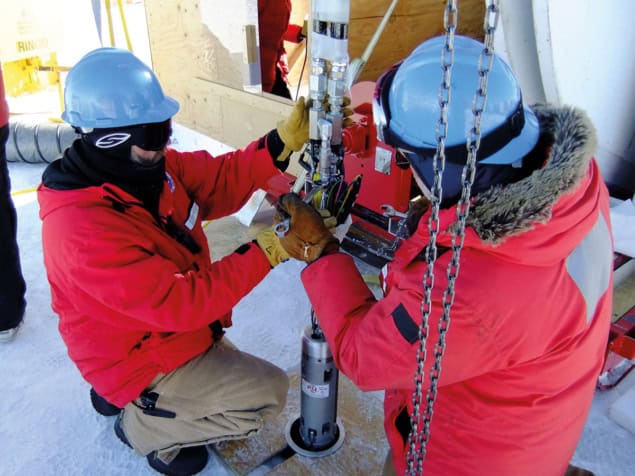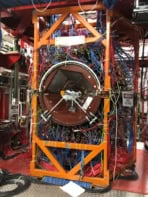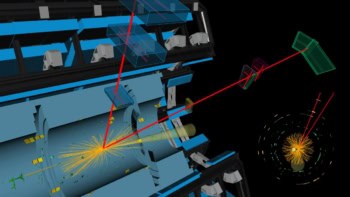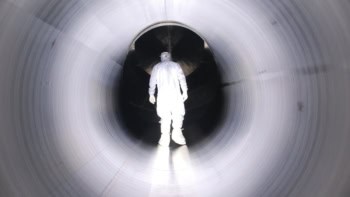A huge neutrino detector is currently being built at the South Pole to understand the origins of high-energy cosmic rays. Jude Dineley looks at the challenges in constructing the Askaryan Radio Array

Ultra-high-energy cosmic rays are an enigma. They bombard the Earth with energies of more than 1020 eV – over 10 million times greater than the energies generated at CERN’s Large Hadron Collider. And yet, where ultra-high-energy cosmic rays originate and what accelerates them is still a mystery. Astrophysicists are hoping such questions will be answered by the $8m Askaryan Radio Array (ARA) that, if funded, will come fully online at the South Pole in the coming decade. Consisting of 37 nodes or “stations”, the ARA will sit on the 3 km-high Antarctic plateau and eventually span an area of 200 km2.
The ARA is a large international collaboration consisting of 50 researchers from some 11 institutions, including the University of Wisconsin-Madison in the US and the National Taiwan University (NTU) in Taipei. All the ARA partners are involved in existing Antarctic cosmic-neutrino detectors: IceCube – a 1 km3 detector embedded 2.5 km deep in the ice that reported its first detection of neutrinos with energies up to 1015 eV in 2013 – and the balloon-borne ANITA detector. ANITA, which is yet to make a confirmed detection, surveys around 1.5 million square kilometres of ice from 37 km up in the atmosphere and is sensitive to neutrinos with energies above 1019 eV.
The ARA will explore the so-far uncharted energies between IceCube and ANITA. Its main goal is to detect ultra-high-energy neutrinos that are predicted to result from interactions between high-energy cosmic rays and the cosmic microwave background in the vicinity of the unknown cosmic accelerators. Unlike the particles that make up cosmic rays, such as protons, neutrinos have no charge and next to no mass, meaning that those emitted from the edge of the universe can, in principle, reach Earth undeflected by fields and matter in the cosmos.
Spotting neutrinos
Building a detector at the South Pole might seem a perverse thing to do, but the beauty of Antarctica is that it has the largest expanse of ice in the world. And ice – being a dense, radio-transparent dielectric – is ideal for glimpsing neutrinos, which are notoriously hard to spot. Moreover, the ability to detect neutrinos improves the deeper you go. “We found that if we deployed the sensors at a depth of 200 m, then we have a factor of three times higher sensitivity than if we leave them at the surface,” says Albrecht Karle of the University of Wisconsin-Madison, who is managing the ARA’s deployment.
Each of the ARA’s 37 stations will detect radio waves over 50 km3 of ice and will be placed around 2 km apart on a hexagonal grid. Stations have been designed as stand-alone interferometers, enabling the three stations already deployed to start observing. Working over two intense summer seasons, each lasting six to eight weeks, the collaboration installed the prototype testbed station at the surface of the ice in late 2010 as well as the three full stations – one at 100 m and two at 200 m below the surface of the ice – in 2011 and 2012. The telescope will become more sensitive as each new station gets added – an approach that leaves the door open for the total number of stations to eventually expand beyond just 37.
Chosen for reliability and cost-efficiency, the 37 stations will be powered by the generators that supply the Amundsen-Scott South Pole Station with electricity. They will be connected by cables, which, along with data links, will run as far as 15 km across the ice to reach the most remote stations. It is estimated that the ARA will draw under 5 kW – less than 1% of the total power consumption at the South Pole Station.
Each ARA station will have 16 receiver antennas, divided into eight pairs spread across four detector “strings” suspended vertically in the ice to a depth of 200 m. Each pair comprises one horizontally and one vertically polarized antenna. The antennas will detect neutrinos by looking for the radio waves emitted when these tiny neutral particles collide with nuclei in the ice – a phenomenon called the Askaryan effect. By measuring the sequential arrival of the pulse at the antennas, the direction and the curvature of the wavefront can be deduced. From this information, the distance of the neutrino–ice interaction from the station can be calculated, which when combined with the pulse magnitude, can be used to determine the energy of the interaction.
Fine-tuned to maximize sensitivity, Karle estimates that the ARA will detect up to 10 events per year. Frequency and polarization characteristics detected by the antennas will also help improve the location of the events in the ice – a step towards locating neutrino sources in the sky. “By knowing their incoming energy and angle, we can point back to certain suspect astrophysical objects,” says Pisin Chen of the NTU, which is funding one quarter of the stations. These could include supermassive black holes found in active galaxies and gamma-ray bursts. However, the ARA’s primary goal, as Karle stresses, is to detect the particles in the first place. “Our priority is to detect events reliably,” he says. “Once we have nailed that, then it will be a different game.”
Drilling down under
Members of the collaboration are facing some significant challenges in building the ARA. As mechanical engineer Terry Benson of the University of Wisconsin-Madison points out, one particular problem is that the harsh conditions, remote location and associated logistics mean that the drills that are used to bore holes in the ice must be robust, easy to repair and fuel-efficient. In fact, Benson and colleagues have pioneered drilling technology with these criteria in mind. Their approach melts the ice with pressurized water at a temperature of 85 °C and then rapidly pumps it to the surface, leaving a dry hole. This means that the detectors do not need to be waterproofed from the melted ice or shielded as it refreezes and expands.
Yet, the technique carries a risk that equipment can get damaged and lost in the ice. “Keeping water liquid at the South Pole is hard to do,” explains Benson, who has worked eight summers in Antarctica since 2004. “If you have delays when the drill equipment is sitting in the hole, it can freeze in and you can’t get it out.” But in addition to good design, meticulous preparation and instruments that can monitor the holes during drilling, Benson singles out experience as the most important factor. Safety is another top priority, with hazards including the hot, pressurized drill water and high-voltage power, not to mention the harsh environment. Indeed, crews are equipped with survival packs in case they get injured or exposed to poor weather conditions that could stop them returning quickly to the South Pole Station.
Chen’s NTU group, which built the second and third stations, is now assembling additional ones in Taipei. However, for now, their installation is on hold. While money from Taiwan and other non-US states is in place, it is unclear if or when the National Science Foundation (NSF) will provide the ARA’s US partners with the funding needed for deployment. “It’s the US that has the capability of transporting all of the equipment to the pole. Most other countries are not able to do it, so that’s becoming a bottleneck,” says Chen, who adds that the US contribution is “very crucial”. If funding is secured in time for construction over the 2016–17 Antarctic summer, Karle estimates the array will be completed by 2022. Yet the ARA is not the only neutrino experiment being built at the South Pole: the ARIANNA facility, which will be located on the Ross Ice Shelf, is in the early stages of construction and will search more than 500 km3 of ice at the same energies.
Amy Connolly – a physicist at Ohio State University who is working with colleagues on simulations of neutrino detections by the ARA and analysing its first data – says that the prototype testbed has provided a successful proof of principle and made the first observations of background noise, proving that it will not overwhelm signals from true neutrino events. By feeding the data into simulations of a full station, the collaboration is also developing techniques to maximize sensitivity. “Based on our experience with the testbed, we can say more definitely that with a full ARA, we can really dig deep into the expected flux of cosmogenic neutrinos and begin to do real physics and astrophysics,” says Connolly. Funding permitting, it would seem that the ARA has a bright future. “It’s going to be a very powerful experiment,” says Connolly. “If the NSF will only just allow us to build it.”



